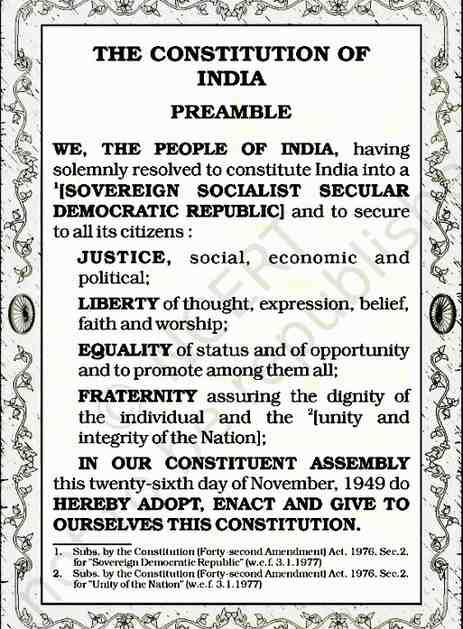Preamble of India UPSC Notes: Meaning, Objectives, Resolution & Landmark Cases Explained
Oct, 2025
•4 min read
The Preamble of India is a key topic for the UPSC Civil Services Examination, particularly under Polity (GS Paper II). Questions often assess your understanding of its philosophical ideals, historical background, key terms, and its role in interpreting the Constitution.
Here, we’ll cover the Preamble, its meaning, significance, ideals, evolution, and interpretation by the Supreme Court.
What is the Preamble?
The Preamble is the introductory part of the Indian Constitution, outlining its philosophy, objectives, and guiding principles. It expresses the source of authority of the Constitution, the people of India, and declares India to be a Sovereign, Socialist, Secular, Democratic, and Republic nation.
It reflects the ideals and vision of the Constitution-makers, inspired by the Objectives Resolution moved by Jawaharlal Nehru in 1946. The Preamble serves as a guiding light for interpreting the Constitution and ensuring that all its provisions work towards achieving justice, liberty, equality, and fraternity for all citizens.
Key Points:
- Eminent jurist N.A. Palkhivala called it the "Identity Card of the Constitution".
- K.M. Munshi described it as the "Political Horoscope of the Constitution".
- The Preamble is not directly enforceable in a court of law, but acts as a guiding principle for interpreting constitutional provisions.
- It provides an overview of the four main elements: the source of the Constitution, the nature of the Indian State, the statement of objectives, and the date of adoption.

Historical Background of the Preamble
The journey of the Preamble is deeply connected to India's freedom struggle and constitutional development.
Objectives Resolution - The Foundation:
The Preamble is based on the Objectives Resolution moved by Jawaharlal Nehru in the Constituent Assembly on December 13, 1946. This resolution laid down the fundamental principles that would guide the drafting of the Constitution.
- The Objectives Resolution was introduced by Jawaharlal Nehru on December 13, 1946.
- The resolution was formally adopted by the Constituent Assembly on January 22, 1947.
- It declared India an independent sovereign republic.
- It promised justice, equality, and freedom to all citizens.
- Adequate safeguards were provided for minorities and backward classes.
Drafting Process:
- B.N. Rau, the Constitutional Adviser, prepared an initial draft of the Preamble on 1st October 1947.
- The Drafting Committee, chaired by B.R. Ambedkar, published the revised Draft Constitution of India on February 21, 1948.
- The Preamble was finally adopted by the Constituent Assembly on November 26, 1949.
- It came into force on January 26, 1950, celebrated as Republic Day.
Artistic Excellence:
- Prem Behari Narain Raizada was the calligrapher of the English version of the Constitution.
- Beohar Rammanohar Sinha illuminated and beautified the original Preamble page.
- The artists from Shantiniketan, including Nandalal Bose and his team, created the illustrations.
Also read: Lokpal and Lokayukta: UPSC Polity Notes
Features of the Preamble
The Preamble contains several distinctive features that make it unique and comprehensive. Here are the key features:
- Reflection of Core Values: The Preamble embodies the fundamental principles and constitutional values that guide the entire Constitution.
- Source of Authority: It clearly indicates that the source of the Constitution's authority lies with "We, the people of India," establishing popular sovereignty.
- Nature of the State: It declares India as a Sovereign, Socialist, Secular, Democratic Republic.
- Objectives and Ideals: It outlines the objectives of Justice, Liberty, Equality, and Fraternity.
- Unity in Diversity: The Preamble promotes national integration by emphasizing the unity and integrity of the nation.
- Guide for Interpretation: Though not directly enforceable, it serves as a guiding light for interpreting constitutional provisions when language is ambiguous.
- Historical Significance: It mentions the date of adoption - November 26, 1949 - marking a historic moment in Indian democracy.
Also read: Constitutional Bodies in India
Important Key Words in Preamble
The Preamble contains several key words that define the character and objectives of the Indian State.
1. Sovereign:
- India has its own independent authority and is not under the control of any external power.
- The legislature has the power to make laws subject to constitutional limitations.
- India can acquire foreign territory or cede part of its territory as a sovereign nation.
2. Socialist:
- Added by the 42nd Amendment in 1976.
- Represents the State's commitment to achieving a welfare state.
- Indicates faith in a mixed economy where both public and private sectors coexist.
- Focuses on reducing economic inequalities and promoting social justice.
3. Secular:
- Added by the 42nd Amendment in 1976.
- The State has no official religion of its own.
- All religions receive equal respect, protection, and support from the State.
- Represents one facet of the right to equality.
- Secularism is a basic feature of the Constitution, as held in the S.R. Bommai case
4. Democratic:
- The Constitution has an established form that derives its authority from the will of the people.
- Citizens elect their representatives through free and fair elections.
- Representatives are accountable to the people.
5. Republic:
- The head of State is an elected representative and not a hereditary monarch.
- In India, the President is elected indirectly by an electoral college.
- This ensures that the highest public office is accessible to all citizens regardless of birth or background.
6. Justice:
- Encompasses social, economic, and political dimensions.
- Secured through Fundamental Rights and Directive Principles of State Policy.
7. Liberty:
- Freedom of thought, expression, belief, faith, and worship.
- Subject to law and public morality.
8. Equality:
- Absence of discrimination and special privileges.
- Provision of adequate opportunities for all.
9. Fraternity:
- A sense of brotherhood among all citizens.
- Assures the dignity of the individual and the unity and integrity of the nation.
Also read: Quit India Movement 1942 UPSC Notes | Modern History & Freedom Struggle
Important Supreme Court Judgments on the Preamble
Several landmark Supreme Court judgments have shaped our understanding of the Preamble's status and significance. Let’s understand how!
1. Berubari Union Case (1960):
The Supreme Court delivered its first significant opinion on the Preamble in this case.
- Issue: Whether the Nehru-Noon Agreement for transferring the Berubari territory to Pakistan required a constitutional amendment.
- Judgment: The Court held that the Preamble is not a part of the Constitution.
2. Kesavananda Bharati Case (1973):
This landmark judgment revolutionized the understanding of the Preamble's status.
- Issue: Whether Parliament's power to amend the Constitution under Article 368 is unlimited.
- Judgment on Preamble: The 13-judge bench held that the Preamble is an integral part of the Constitution.
Key Holdings:
- The Preamble can be amended under Article 368 like any other part of the Constitution.
- However, amendments cannot alter the basic structure or fundamental features enshrined in the Preamble.
- Basic Structure Doctrine: The Court established that certain fundamental features like sovereignty, democracy, secularism, and justice cannot be destroyed by amendments.
3. LIC of India Case (1995):
The Supreme Court reaffirmed the constitutional status of the Preamble.
- Context: Challenge to LIC's insurance policy conditions under Articles 14, 19(1)(g), and 21.
- Judgment: The Court again held that the Preamble is an integral part of the Constitution.
- Significance: This judgment reinforced the importance of the Preamble as a guiding principle for constitutional interpretation.
4. Union of India v. Madan Gopal Kabra (1954):
An early case recognizing the importance of the Preamble.
- Holding: The Court observed that "our constitution, as appears from the preamble, derives its authority from the people of India".
- Significance: This case recognized the concept of popular sovereignty embodied in the Preamble.
5. S.R. Bommai v. Union of India (1994):
A landmark judgment on federalism and secularism.
- Context: Challenge to the misuse of Article 356 (President's Rule) in states.
- Judgment on Preamble: The Court held that secularism is a basic feature of the Constitution.
- Key Observation: The Court defined secularism as positive equality - equal treatment of all religions rather than mere tolerance.
- Impact: Religion and politics should remain separate; political parties engaging in communal politics violate constitutional principles.
6. Minerva Mills v. Union of India (1980):
An important case on the balance between Fundamental Rights and Directive Principles.
- Context: Challenge to Sections 4 and 55 of the 42nd Constitutional Amendment Act.
- Judgment: The Court struck down amendments that gave Directive Principles supremacy over Fundamental Rights.
- Relevance to Preamble: The Court held that the Preamble's promise of justice, liberty, and equality requires a balance between rights and duties.
- Key Principle: Parliament's power to amend is limited and cannot destroy the basic structure reflected in the Preamble.
Multiple Choice Questions
QUESTION 1
Easy
What was the exact constitutional status of India on 26th January, 1950?
Select an option to attempt
Can the Preamble Be Amended?
The Preamble can be amended under Article 368 of the Constitution, subject to certain limitations and conditions. Here are the key rulings:
- Kesavananda Bharati Case (1973): The Supreme Court held that the Preamble is part of the Constitution and can be amended like any other provision.
- Condition for Amendment: Any amendment to the Preamble must not violate or destroy the basic structure or fundamental features of the Constitution.
- Basic Features Protected: Elements like sovereignty, democracy, secularism, socialism, republic, justice, liberty, equality, and fraternity cannot be altered in a manner that destroys their essence.
- Historical Amendment: The Preamble has been amended only once so far through the 42nd Constitutional Amendment Act, 1976.
- Changes Made: Three words - "Socialist," "Secular," and "Integrity" - were added to the Preamble.
- Original Text: The words "Sovereign Democratic Republic" were changed to "Sovereign Socialist Secular Democratic Republic".
- Unity Changed: The phrase "unity of the Nation" was changed to "unity and integrity of the Nation".
- Validity of Amendment: This amendment was held to be constitutionally valid as it did not destroy the basic structure.
- Special Majority Required: Amendment of the Preamble requires a special majority under Article 368 - two-thirds of members present and voting in each House of Parliament.
- Judicial Review: Any amendment to the Preamble can be challenged in courts on the ground that it violates the basic structure doctrine.
Significance of the Preamble
The Preamble to the Indian Constitution is known as the soul and guiding light of the Constitution. It serves as the moral and philosophical foundation upon which the entire constitutional framework is built. Here’s why the Preamble is highly significant:
- Soul of the Constitution: Embodies the fundamental principles and philosophy of the Constitution.
- Guiding Light for Interpretation: Courts use it as an interpretive tool for ambiguous constitutional provisions.
- Source of Constitutional Authority: Establishes that power comes from "We, the People of India," reflecting popular sovereignty.
- Constitutional Identity: Defines India as Sovereign, Socialist, Secular, Democratic, and Republic.
- Reflection of Historical Struggles: Pays tribute to freedom fighters and their sacrifices.
- Non-Justiciable but Integral: Not directly enforceable, but is an integral part of the Constitution.
- Guide for Amendments: Ensures amendments do not violate the basic structure of the Constitution.
UPSC Mains Practice Question
Explain the key ideals of Justice, Liberty, Equality, and Fraternity as embodied in the Preamble of the Indian Constitution and their importance for contemporary India.
Evaluate Your Answer Now!Conclusion
The Preamble embodies the hopes, dreams, and aspirations of millions of Indians who fought for freedom and envisioned a just, equal, and dignified society. Understanding the Preamble is essential for every UPSC aspirant as it forms the foundation upon which the entire constitutional edifice rests.
SuperKalam – Your 24x7 AI Mentor for UPSC!
- Instant Doubt Resolution
- Instant Mains Answer Evaluation for GS, Ethics & Essay
- Unlimited MCQ & PYQ Practice
Start your free trial today and experience smart learning!


